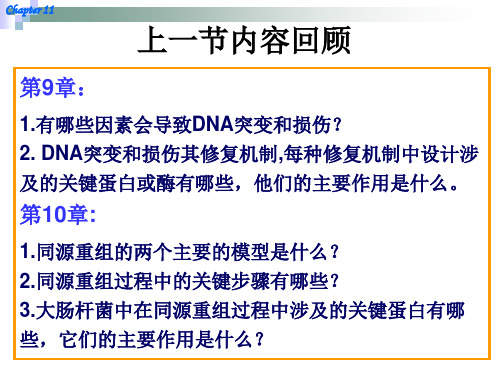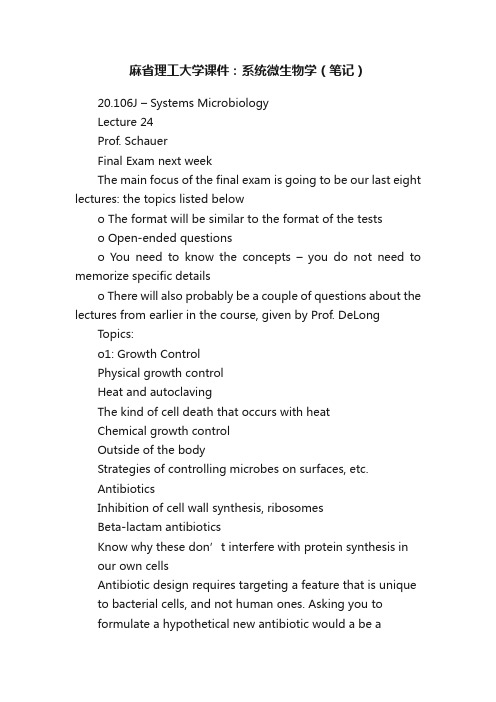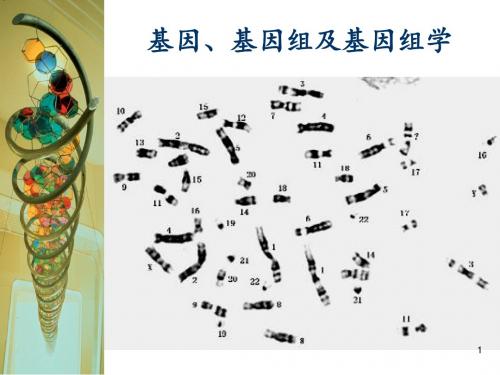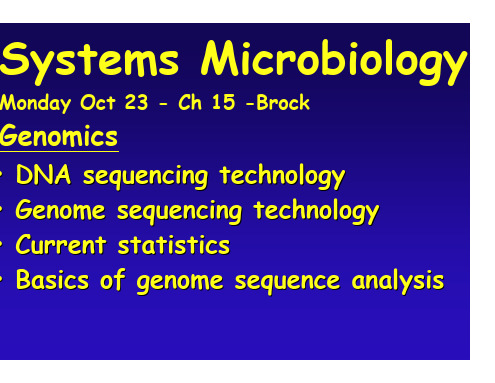麻省理工大学课件:系统微生物学11-基因组学I(笔记)
基因组学概述 PPT课件

• 哌啶:从修饰甲基处断裂核苷酸链。
在不同的酸、碱、高盐和低盐条件下,三 种化学试剂按不同组合可以特异地切割 核苷酸序列中特定的碱基。
• G反应:DMS使G在中性和高温条件下脱 落。
• G+A反应:酸性条件(如甲酸)可使A 和G嘌呤环上的N原子质子化,利用哌啶 使A、G脱落。
• 高等真核生物(如人类)基因组中有大量 重复序列,导致判断失误。
鸟枪法测序的缺点
对鸟枪法的改进
(1) Clone contig法。首先用稀有内切酶把待测基因组降 解为数百kb以上的片段,再分别测序。 (2) 靶标鸟枪法(direted shotgun)。首先根据染色体上已 知基因和标记的位置来确定部分DNA片段的相对位置, 再逐步缩小各片段之间的缺口。
3.基因工程所用的vector实际上是DNA分子,是用来 携带目的基因片段进入受体细胞的DNA。
载体的分类
分类依据 1.按功能分成
类
别
(1)克隆载体 (2)表达载体
2.按进入受体细胞类 型分
3.按载体来源分 4.按克隆片段得大小 (克隆能力)分
(1)原核载体 (2)真核载体 (3)穿梭载体
病毒载体+
• T+C反应:肼(低盐)
• C反应:肼(高盐)
测定DNA长度~250bp。
化学裂解法测定DNA的核苷酸序列
杂交法SBH
(Sequencing by hybridization)
• 用特定长度的具有所有可能碱基序列的 寡核苷酸探针与未知序列的DNA片段杂 交。根据某些探针形成的完全双链,推 知目的DNA的碱基序列。
分子生物学教学课件:11 章 Site-Specific Recombination

Chapter 11
Genome
ቤተ መጻሕፍቲ ባይዱ
DNA replication Stable: repair
homologous recombination
Conservative site-specific Dynamic: recombination (CSSR)
Impact on the chromosome structure and function
Chapter 11
2-1 l integrase promotes the integration and Excision of a Viral Genome into the Host Cell
Chromosome
Bacteriophage l infects a host bacterium and would establish a lysogen ,which requires the integration of phage DNA into host chromosome
Some recombination requires only the recombinase and its recognition sequence for such an assembly; some requires accessory proteins including Architectural Proteins that bind specific DNA sequences and bend the DNA.
这种机制也常见于DNA拓扑异构酶和Spo11,后 者运用这种机制在减数分裂期间诱导DNA双链断 裂引发同源重组。
Chapter 11
1-3 Serine recombinases introduce DSB in DNA and then swap strands to promote
麻省理工大学课件:系统微生物学(笔记)

麻省理工大学课件:系统微生物学(笔记)20.106J – Systems MicrobiologyLecture 24Prof. SchauerFinal Exam next weekThe main focus of the final exam is going to be our last eight lectures: the topics listed belowo The format will be similar to the format of the testso Open-ended questionso You need to know the concepts –you do not need to memorize specific detailso There will also probably be a couple of questions about the lectures from earlier in the course, given by Prof. DeLong Topics:o1: Growth ControlPhysical growth controlHeat and autoclavingThe kind of cell death that occurs with heatChemical growth controlOutside of the bodyStrategies of controlling microbes on surfaces, etc.AntibioticsInhibition of cell wall synthesis, ribosomesBeta-lactam antibioticsKnow why these don’t interfere with protein synthesis inour own cellsAntibiotic design requires targeting a feature that is unique to bacterial cells, and not human ones. Asking you toformulate a hypothetical new antibiotic would a be areasonable question on the test.Antibiotic resistanceKnow that the existence of antimicrobial resistancepredated our own medical use of antibiotics. Why is that?o2: Microbe-host InteractionsHealthcare-associated infections (HAI)Know about the acquisition of drug resistance by some ofthese microbes in peopleVRE, MSRAThe fear of developing a superbug that we have to drug to treatCommensal microbiota (ecology, models)You should be familiar with the concept that there aremicrobes that live in every living thing on earthKnow about the development of a climax community ofmicrobiota in the human gut as people grow up frominfants to adultsGnotobiotic animals: in the lab, people can create rabbits,mice, or pigs grown in a sterile environment so that theyhave no microbiota inside them.You might be able to make some comparisons between our endosymbionts and those of aphidso 3.4: Immunology I and IIImmune cellsBe familiar with the main components of the immunesystemKnow the main components of lymphocytesKnow what B and T cells do once they become activated,what they secreteInflammation, phagocytosisNatural immunityGetting microbes out of the injured siteAdaptive immunity (Ag, MHC, T, B)Know the way that antibodies recognize antigens, ascompared to the way that T cells can recognize themB cells bind to conformational antigensAffinity maturationo Creates a little extra diversity in a B cell responseo However, this does not happen in T cells, because itwould be catastrophic to have T cells that recognizedifferent things –you don’t want them to startattacking your own cells. They need to recognizeyour own MHCVaccines (types)Know about the general types of vaccinesYou won’t have to name specific vaccinesUnderstand the range of successful vaccines that have been usedFor example, there’s the TB vaccine, which only protectsagainst childhood TB. You can’t give a vaccine like that to immuno-suppressed people – it could kill themAnergy (tolerance)HypersensitivityType I: IGEType IV: TB test is an exampleo5: Diagnostic MicrobiologyExotoxins: A-B toxins, SAg (Super antigens)Super antigens bind to the conserved parts of the TCR and the APCo They stimulate large numbers of T cells that sharecommon variable regions of the Beta chaino Whole sale stimulation, release of large quantitiesof cytokinesSelective, differential mediaSelective media to inhibit growth of commensalsYou can also make differential media, such as adding sugars or pH sensitive dyesMAb, serologyo6: Person-to-person TransmissionTB (risk factors, pathogenesis)Many people get exposed, many people develop latent infectionsIf they become immuno-suppressed, they can develop active TBInfluenzaAntigenic shifto Large, sudden changesAntigenic drifto Small changes in the proteins compromise the ability of your system to protect you from the virus Hp Only a small proportion actually develop peptic ulcer diseaseo7: EpidemiologyTermsIncidence, prevalence, control, transmission Emerging infectious diseaseso8: Arthropod-borne and Zoonotic DiseasesPlague (epidemiology, pathogenesis)Wild rodents, transmission through fleas on a sporadic basisBe familiar with how plague affects the flea life cycle, causing it to bite more peopleBubonic, Systemic, and Pneumonic forms of plague。
研究生基因组学PPT课件

目 录
• 基因组学概述 • 基因组学基础知识 • 基因组学研究方法 • 基因组学在医学中的应用 • 基因组学在农业中的应用 • 基因组学的伦理、法律与社会问题
01
基因组学概述
基因组学的定义与特点
总结词
基因组学的定义、特点与研究对象
详细描述
基因组学是一门研究生物体基因组的学科,其研究对象包括基因组的组成、结构、功能和演化等方面的内容。基 因组学具有系统性、整体性和复杂性等特点,其研究范围涵盖了基因组的结构、功能、进化以及基因组与环境之 间的相互作用等多个方面。
研究作物耐盐碱的基因基础,有助于 培育出能在盐碱地生长的作物品种, 扩大可耕地面积,提高农业生产效益。
抗病性基因
发掘和利用作物的抗病性基因资源, 可以培育出抗病性更强的品种,减少 农药使用,降低生产成本,同时保障 食品安全。
转基因技术与作物改良
转基因技术原理
转基因技术是一种将外源基因导入到生物体基因组中的技术,通 过该技术可以改良作物的性状和产量。
息被滥用或泄露。
基因歧视与公平性问题
基因歧视的问题
基因检测可以揭示个体的遗传疾病风险,这可能会引发 就业、保险等方面的歧视问题。政府应该制定相关法律 和政策,禁止基于基因信息的歧视行为。
公平获取基因技术的机会
虽然基因技术可以带来巨大的益处,但并不是每个人都 能公平地获得这些技术。政府和社会应该采取措施,确 保所有人都能公平地获得基因检测和治疗的机会。
基因表达与调控
基因表达
是指基因经过转录和翻译,将遗传信息转化为蛋白质或RNA分子的过程。
基因调控
是指对基因表达的调节和控制,以确保生物体在生长发育和应对环境变化时能够做Байду номын сангаас适当的反应。
(推荐)《微生物基因组学》PPT课件

关于基因组学的范畴
• 随着基因组和基因组学这两个术语变得流行起来,一系列 新的术语也)的名称,而被研究的对象则被称为“ …… 组”(-ome)。例如蛋白质组和蛋白质组学。
• 一个蛋白质组(proteome)表示某个时刻在一个细胞或生 物体中全部的蛋白质组成。其它类似的词还有转录组、代 谢组、糖组和变异组。这些新兴的领域能否归到“基因组 学”之下,尚有较大的争议。
在代谢中的可能作用分析; ➢ 通过分析相关基因活性帮助建立细胞中完整的代
谢网络; ➢ 疾病诊断与预测;疫苗与药物的开发; ➢ 基因进化、乃至物种进化的分析
14
二、从DNA双螺旋到微生物基因组
15
基因组学发展的历史
• 基因组时代的奠基石: ➢ DNA双螺旋结构的提出 ➢Sanger双脱氧末端终止法测序 和DNA自动测序仪的发明 ➢PCR技术 ➢生物信息学软硬件设施的发展 ➢……
• 1987年,Victor Mckusick 和 Frank Ruddle 一起创 办了“genomics”杂志,这是第一次“genomics” 这个词在科学界得到广泛的应用。
7
• 基因组学领域包括DNA测序、在物种内进行基因组多 样性的采集以及基因转录调控的研究,即基因组学覆 盖了从DNA序列分析到研究生物体对环境干扰的响应 这样比较广的范围。
微生物基因组学
•主讲教师: 李林 博士/副教授
•Phone: 87286952 •Email: lilin@
1
教学内容
第一部分 微生物基因组学的发展历史和意义
1、基因组和基因组学的定义; 2、从DNA双螺旋到微生物基因组; 3、微生物基因组计划概况和重要意义; 4、几种重要微生物基因组的测序; 5、微生物基因组学网络资源介绍。
基因基因组及基因组学ppt课件

遗传图与物理图的整合
有些标记既是遗传标记,又是物理标 记,如RFLP标记、SSR标记和某些基 因序列
借助这些标记可以将遗传图和物理图 整合起来
43
序列图谱(分子水平的物理图谱)
以某一染色体上所含的全部碱基顺序绘制的图 谱。
既包括可转录序列,也包括非转录序列,是转 录序列、调节序列和功能未知序列的总和。
优点:不受环境影响 缺点:数量少、费力、费时、对生物体的生
长发育不利
19
生化标记
又称蛋白质标记 就是利用蛋白质的多态性作为遗传标记。
如同工酶 优点:数量较多,受环境影响小 缺点:受发育时间的影响、有组织特异性、
只反映基因编码区的信息
20
DNA分子标记
简称分子标记,以DNA序列的多态性作为遗 传标记 随着分子生物学的发展,相继建立 了RFLP、TRS、SNP等多种分子遗传标记检 测技术,开创了遗传标记研究的新阶段。 优点:
用于确定各遗传标记间的物理距离有两种物理图谱:
(1)以已定位的DNA序列标记位点(STS)为位标,以DNA实际长 度为图谱距离的基因组图谱。
(2)由YAC和/或细菌人工染色体(BAC)连续克隆重叠群组成的 物理图谱。
36
物理作图的方法
1、限制酶作图 2、依靠克隆的基因组作图 3、荧光原位杂交 4、序列标签位点作图
16
形态标记
形态性状:株高、颜色、白化症等 又称表型标记 控制性状的其实是基因,所以形态标记实
质上就是基因标记。
数量少 很多突变是致死的 受环境、生育期等因素的影响
17
伯乐相马
按图索骥
18
细胞学标记
明确显示遗传多态性的染色体结构特征和数 量特征: 染色体的核型 染色体的带型 染色体的结构变异 染色体的数目变异
基因组学基本知识ppt课件

物种遗传信息的“总词典”、控制发育的“总程序”、 生物进化历史的“总档案”
ppt课件.
3
基因组学研究的最终目标
获得生物体全部基因组序列 鉴定所有基因的功能 明确基因之间的相互作用关系 阐明基因组的进化规律
析基因的大小、数量,基因排列顺序,编码序列与非编码 序列的特征等,以揭示物种进化关系,克隆重要性状基因 和进行遗传研究和性状改良。
ppt课件.
18
四、基因组学的应用
确定物种特有的序列 研究物种的遗传多样性 研究物种的起源及系统进化 进行新基因的克隆(染色体步移) 进行基因功能的预测 获得功能分子标记
子机制 ➢ 确定人类基因组中转座子、逆转座子和病毒残余序列 ➢ 研究染色体和个体之间的多态性
ppt课件.
10
(5)研究进展 ➢ 1996年,完成标记密度为0.6cM的人类基因组遗 传图谱,100kb的物理图谱 ➢ 2000年,人类基因组框架草图绘制完成 ➢ 2001年2月,人类基因组精细图谱的完成 ➢ 2002年,完成测序工作
(3)研究目的 找出所有人类基因,破译出人类全部遗传信息, 使得人类在分子水平上全面认识自我 将基因用于改善人类的生活质量 解决人类疾病、健康的问题
ppt课件.
9
(4)研究意义
➢ 确定人类基因的序列、物理位置、产物及功能 ➢ 理解基因转录与转录后调节 ➢ 研究空间结构对基因调节的作用 ➢ 发现与DNA复制、重组等有关的序列 ➢ 研究DNA突变、重排和染色体断裂等,了解疾病的分
与病原基因组中的直接或间接作用的结果。 “全基因组”信息记录着一个人有关生、老、
微生物基因组学_PPT幻灯片

“双脱氧末端终止”的含义
Sanger 双脱氧末端终止法测序原理
自动化测序
荧光染料标记物的发明: 使链终止法用于自动化测序,用不同的荧光 色彩标记ddNTP,如ddATP标记红色荧光, ddCTP标记蓝色荧光,ddGTP标记黄色荧光, ddTTP标记绿色荧光。由于每种ddNTP带有 各自特定的荧光颜色,而简化为由1个泳道同 时判读4种碱基。
(四)影响测序的因素 不管采用随机测序还是定向测序都可碰到下列影响因素。 1.计算机的设备 。 2.靶DNA的性质。 3.完成测序所需的时间 。 4.采用测序策略。
三.微生物基因组的注释 (一)概念:在微生物基因测序的基础上,对其基本结 构和部件进行认定,以进一步研究其功能。
(二)微生物基因组注释的内容 1.碱基组成分析,即G+C Mol%测定。 G+C含量是物种的一个重要特征,在微生物的分类上具有重要意义,是重 要参数之一。 2.开放阅读框的鉴定: 3.编码序列分析
向测序法包括引物测序法和定向缺失测序法。 ⑴引物测序法 即在第一次测序结果的基础上,设计新的寡核苷酸,来充当下一次测
序反应的引物,并依次类推,从而循序渐进获得靶DNA的全部序列。
⑵定向缺失法 定向缺失法是将一个靶DNA变成若干套嵌套的缺失突变体,使靶序列中远
不可测的区段逐渐落入可用通用引物进行测序的方法。
黏粒载体( cosmid )
P1人工染色体载体(PAC)
目前常用的人造染色体载体
23
YAC载体应含有下列元件:
酵母染色体的端粒1 EcoRI CEN4
酵母染色体的着丝粒序列 Apr
pYAC
URA3
4
酵母系统的选择标记
ori
大肠杆菌的复制子标记
麻省理工大学课件:系统微生物学11-基因组学I(PPT)

Monday Oct 23 - Ch 15 -Brock
Genomics
• DNA sequencing technology • Genome sequencing technology • Current statistics • Basics of genome sequence analysis
The Race to Sequence
Cartoon image of J. Craig Venter and Francis Collins racing to the finishremoved due to copyright restrictiaig Venter • NHGRI - Francis Collins • G5
– Sanger Centre – Whitehead Institute
– JGI Walnut Creek
– Washington University – Baylor
Human Genome Project
• HGP drove innovation in biotechnology
• 2 major technological benefits
3. Four reactions are set up, each containing:
1. DNA template 2. Primer annealed to template DNA 3. DNA polymerase 4. dNTPS (dATP, dTTP, dCTP, and dGTP)
7. Each of the four reaction mixtures produces a population of DNA molecules with DNA chains terminating at all possible positions.
第23章基因组学PPT课件

Genomics
第1页/共18页
一、基因组学概念及范畴
基因组(genome) 泛指一个有生命体、病毒或细胞器的全部
遗传物质;在真核生物,基因组是指一套染色 体(单倍体)DNA。
基因组学(genomics) 就是发展和应用DNA制图、测序新技术以
及计算机程序,分析生命体(包括人类)全部基 因组结构及功能。
• HGP的内容就是制作高分辨率的人类遗传图和 物理图,最终完成人类和其它重要模式生物全 部基因组DNA序列测定,因此HGP属于结构 基因组学范畴。
第4页/共18页
HGP包括以下研究内容
(一)物理制图 (二)遗传制图 (三)基因组DNA序列测定 (四)创建计算机分析管理系统
第5页/共18页
HGP主要任务及内容
第6页/共18页
• 通过HGP获得的广泛基因组信息组成了结构 基因组学的基本内容,是开展功能基因组学的 研究的基础;同时为详尽研究每一个单基因遗 传病提供“平台”,并将成为复杂的多基因遗 传病研究的发端。
第7页/共18页
三、功能基因组学
• 完成一个生物体全部基因组测序后即进入 后基因组测序阶段——详尽分析序列,描 述基因组所有基因的功能,包括研究基因 的表达及其调控模式,这就是功能基因组 学(functional genomics)。
第8页/共18页
主要具体内容包括以下方面
(一)鉴定DNA序列中的基因 (二)同源搜索设计基因功能 (三)实验性设计基因功能 (四)描述基因表达模式
第9页/共18页
功能基因组学研究策略及主要内容
பைடு நூலகம்第10页/共18页
四、比较基因组学
比较基因组学(comparative genomics) 涉及比较不同物种的整个基因组,以便深入 理解每个基因组的功能和进化关系。
- 1、下载文档前请自行甄别文档内容的完整性,平台不提供额外的编辑、内容补充、找答案等附加服务。
- 2、"仅部分预览"的文档,不可在线预览部分如存在完整性等问题,可反馈申请退款(可完整预览的文档不适用该条件!)。
- 3、如文档侵犯您的权益,请联系客服反馈,我们会尽快为您处理(人工客服工作时间:9:00-18:30)。
20.106J – Systems Microbiology
Lecture 11
Prof. DeLong
¾Chapter 15 – Brock
Genomics
o DNA sequencing technology – things have really changed. There’s a real race going on for who can develop the best technology
Human genome project: only around 30,000 genes in the human
code.
The day is not at all far off when doctors will read people’s
genomes to discover what their inherent risks are.
The human genome project involved two main groups – one more
commercially based (J. Craig Venter – Celera), and one more
public, open source, with funding from NIH (Francis Collins –
NHGRI). Also the Sanger Centre, Whitehead Institute…
The human genome project drove innovation in biotechnology. Two major technological benefits:
o Stimulated development of high throughput methods – the assembly line.
It’s not just the individual with a pipette any more – it’s more like a
factory approach (which matters for the social aspect of how science
works).
However, this might work back in the other direction as efficient
machines develop…
o Reliance on computational tools for data mining and visualization of biological information
Biology is rapidly becoming informational science –
bioinformatics and computational biology.
DNA sequencing
o Sanger’s technique
Uses primer extension and DNA polymerase
Dideoxynucleotides halt the replication at particular base pairs.
Then you run for length on a slab gel, and you can tell which base
pairs are at which locations, reading off the sequence and
recording them manually.
o Later people realized that you can use fluorescent labels instead of
radiolabels.
This meant that you didn’t have to deal with radioactivity
It also meant that you could run them all in one lane.
Instead of a slab gel, people use a thin tube, with a fluorescence
detector automatically reading the wavelengths as they come out
the other end.
This method is fast and accurate
o Graph: the progress of the Human Genome Project
o Shotgun genome sequencing – what about the gaps?
Doing a complete sequence for a bacterial genome is still
expensive – around 10 or 20 thousand dollars, but it’s relatively
straightforward.
o Small insert cloning/sequencing
o There are automated plate pickers now
o Some people thought that shotgun sequencing would work (the Celera group used this) but others thought that it wouldn’t (the public consortium
used a different method)
o BAC sequencing – larger segments, you know where they lie on the genome
o Both approaches have advantages: shotgun sequencing is much quicker, but BAC sequencing closes the gaps – the best method is to use some of
both.
o454 Sequencing – Commercial, massively parallel DNA sequencing technology:
Run PCR with beads, each of which attaches to on strand of DNA
Emulsion PCR
Lots of DNA comes from an individual strand.
You pour the reaction over a chip with tiny wells that each fit one bead.
1.5 million reactions all at once
Thus the factory approach to sequencing is no longer necessary – it can all be done in little machines like this.
It’s still pretty expensive, but it’s getting closer, and it’s changing things rapidly.
o The evolution of sequencing is moving towards nano-methods, and pretty soon there will probably be sequencing technologies in hospitals.
Microbial genomes
o The first complete, published microbial genome came in 1995.
o Incomplete bacterial genomes in process is now approaching 2,500.
o Archeal genomes have been studied less.
o Most of the DNA sequencing is happening at select sequencing centers, and it will probably continue to consolidate in this way.
o Archeal genomes are generally smaller.
o The smaller genomes are typically associated with obligate parasites.
There are obligate symbionts in some insects that live inside the
cell and just work as little amino acid factories.
•Called Carsonella
•They have extremely small genomes
•It’s also very very AT rich (very little GC content)
•The genome basically only has replication mechanisms and
the DNA for amino acid synthesis
•These symbionts are on their way toward becoming
essentially organelles
o We’re figuring out what sort of genes scale with genome size.。
